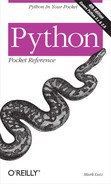Some objects export special attributes that are predefined by Python. The following is a partial list because many types have unique attributes all their own; see the entries for specific types in the Python Library Reference.[6]
X.__dict__Dictionary used to store object
X’s writable attributes.I.__class__Class object from which instance
Iwas generated. In version 2.2 and later, this also applies to object types; most objects have a__class__attribute (e.g.,[].__class__==list==type([])).C.__bases__Tuple of class
C’s base classes, as listed inC’s class statement header.X.__name__Object
X’s name as a string; for classes, the name in the statement header; for modules, the name as used in imports, or"__main__"for the module at the top level of a program (e.g., the main file run to launch a program).
[6] As of Python 2.1, you can also attach arbitrary user-defined
attributes to function objects,
simply by assigning them values. Python 2.X also supports special
attributes I.__methods__ and
I.__members__: lists of method
and data member names for instances of some built-in types. These
are removed in Python 3; use the built-in dir() function.
